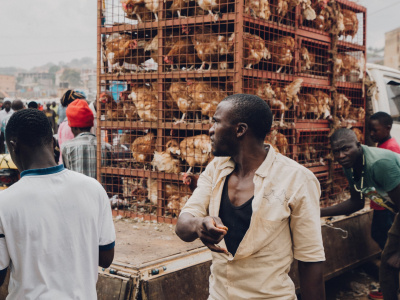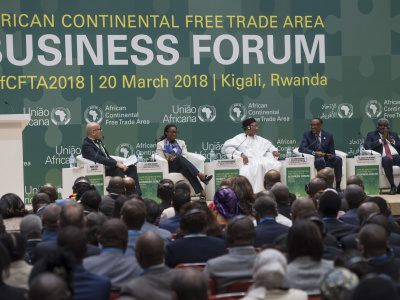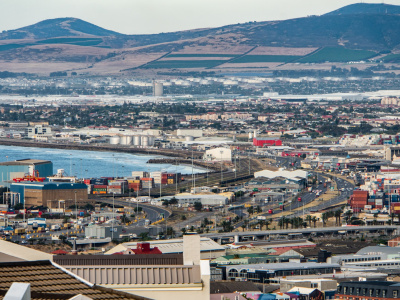
What it would take to provide structural solutions to food insecurity in Africa
A few weeks ago, my colleague Francesco Rampa rightly pointed out the need to seek more structural solutions to Africa’s food insecurity, rather than focusing only on short-term emergency responses. An important question remains: how can this be achieved? And where does the much-talked-about African Continental Free Trade Area (AfCFTA) fit into this?
Intra-African trade to strengthen food security on the continent
As Francesco mentioned, food security in Africa has been worsening, but recent events make its acuteness more apparent. With successive shocks to global food supply chains from external factors, be it climate change or the COVID-19 pandemic, fears of ‘imported volatility’ and instability are once again taking centre stage. The continent is now searching for a policy response to the ongoing war in Ukraine befitting the gravity of the situation. One solution is to increase intra-African trade as a way to raise the resilience of the domestic and regional food markets to shocks.
From this perspective, the AfCFTA is not just an opportunity for economic growth and development, but a necessity to ensure food security and resilience on the continent. However, many things need to happen before increased regional trade becomes a reality, including shifting policy focus towards making food crop production more attractive, creating and strengthening regional food value chains and ensuring sufficient trade infrastructure – all in a politically smart and sensitive way.
Focus on indigenous foods
African countries depend on cash crops such as cocoa, coffee and tobacco to generate foreign exchange, and by and large import food worth up to $43 billion every year. Moreover, these imports mostly come from outside the region. Formally recorded intra-regional trade in agricultural products in Africa is below 20% – among the lowest in the world.
Cereals make up a significant share of food imports, followed by highly (unhealthy) processed foods. This state of affairs can be explained by a confluence of factors, including the organisation of global value chains dominated by a few lead firms so that ‘Northern staple grains [are] traded for Southern high-value products (meats, fruits and vegetables)’.
Policy attention over time has been on ensuring supply through lower import prices to avoid unrest among urban populations, given the ‘urban bias’. On the other hand, production of African staples and other fruits and vegetables has been low, and mainly the reserve of subsistence farmers.
Promoting more diversified diets is a good strategy to adapt to climate change, as Francesco mentions, and avoid the double burden of malnutrition.
Moreover, the AfCFTA could potentially bring a shift in policy focus from subsistence to commercial farming of indigenous foods if continental trade were to become a lucrative activity through increased focus on production and trade.
Need for regional value chains
This remains among the main objectives of the AfCFTA, but it would require boosting capacities throughout the entire food value chain, beyond production, as is often the case (for instance, in Nigeria). Equally important is creating strong linkages with regional markets.
Investments are needed not only along the several stages of the value chain, but also in research and development for African staples and vegetables, which have received less attention. Similarly, extension services would be required to increase yields and boost production.
While creating backward linkages to a strong fertiliser industry, as Francesco mentions, the focus should be on leveraging existing capacity on the continent, for instance in Morocco, Nigeria and several other countries, as well as penetrating the growing biofertiliser market, as new players are increasingly doing.
Access to finance is an important part of the puzzle to undertake the necessary investments. For this, new solutions that take a global approach given the intersectionality between different sectors and needs in Africa (infrastructure, agriculture, climate change and so on) are needed. Moreover, the AfCFTA needs to create financing opportunities for smallholders who rarely have access to formal services, despite being the main producers of food crops.
Other considerations like socio-cultural and gender aspects are key in determining outcomes, as structural gaps in roles and capacities have an impact on the potential for regional food trade. Similarly, while much focus remains on the formal realm, one should not underestimate the role of existing and thriving informal food supply chains in ensuring food security.
Investments in trade infrastructure and systems
Of course, promoting regional food trade through the AfCFTA requires an enabling environment in terms of favourable rules of origin, which provide enough incentives for firms to produce and sell in the regional market.
Similarly, regulatory frameworks to establish quality assurance mechanisms are essential. Without them, the product simply won’t sell or be accepted at the border, as the case of rice in West Africa demonstrates.
Regional trade will not be possible without adequate infrastructure. This includes not just physical infrastructure requirements which remain enormous – $170 billion annually by 2025 – but also soft infrastructure in terms of border procedures and trade facilitation.
The AU’s Boosting Intra-Africa Trade initiative rightly focuses on trade-related policy, finance, facilitation and infrastructure, as well as productive capacity and factor market integration, along with information, to achieve the objective of increased intra-African trade.
Political economy issues
The diversity of actors needed for successful regional value chains – smallholders, commercial farmers and a variety of input and service providers – also suggests that there will be hurdles along the way, especially when interests and incentives do not align. Policies will create winners and losers, and there will be a need for a consultative process to coordinate efforts and avoid potential blockages.
At a broader level, politics matters. In some cases, changing the status quo may affect the patronage networks and other vested interests of political elites. On the other hand, there may be reticence to liberalise food trade given agricultural livelihoods and food security concerns, or it may be liberalised over a very long period, as the AfCFTA negotiations have shown. Many goods – like live animals, meat, fish, milk and dairy products, fruits and vegetables, coffee, tea, spices, oilseeds and sugars – may not be fully liberalised or progressively liberalised over longer periods.
Rather than brushing these under the carpet, it would be more useful to be explicit about these trade-offs and work in a politically smart (rather than politically blind) way to build productive capacities given the particular context.
What is the added value of the AfCFTA?
A lot needs to be done to address these complex and intertwined issues before we can see an increase in intra-African food trade as an outcome. It is important to highlight that trading under the AfCFTA is yet to begin.
Most trade in agricultural products is concentrated within the immediate region and so existing regional free trade areas already provide opportunities to raise regional trade – though admittedly to varying degrees, while the AfCFTA is much more ambitious. Many of these objectives can also be fulfilled by way of a corridor approach, which remains a key development tool used by AUDA-NEPAD, the AU’s development agency.
While a tall order, it fits the AfCFTA’s aspiration of being more than a mere free trade area, to bring about transformative industrialisation.
Greater intra-African trade is not just a potential to fulfil, but should also be seen as having geopolitical and strategic significance given the objective of food security. It requires a more proactive and political stance, and will ultimately determine Africa’s place on the world stage.
The views are those of the author and not necessarily those of ECDPM.





